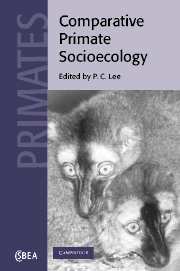Book contents
- Frontmatter
- Contents
- List of contributors
- Preface
- Part 1 Comparative methods
- Part 2 Comparative life history and biology
- Part 3 Comparative socioecology and social evolution
- 10 Lemur social structure and convergence in primate socioecology
- 11 Why is female kin bonding so rare? Comparative sociality of neotropical primates
- 12 Energetics, time budgets and group size
- 13 Ecology of sex differences in great ape foraging
- 14 Hominid behavioural evolution: missing links in comparative primate socioecology
- 15 Evolutionary ecology and cross-cultural comparison: the case of matrilineal descent in sub-Saharan Africa
- Editor's conclusion: Socioecology and social evolution
- Index
12 - Energetics, time budgets and group size
Published online by Cambridge University Press: 24 August 2009
- Frontmatter
- Contents
- List of contributors
- Preface
- Part 1 Comparative methods
- Part 2 Comparative life history and biology
- Part 3 Comparative socioecology and social evolution
- 10 Lemur social structure and convergence in primate socioecology
- 11 Why is female kin bonding so rare? Comparative sociality of neotropical primates
- 12 Energetics, time budgets and group size
- 13 Ecology of sex differences in great ape foraging
- 14 Hominid behavioural evolution: missing links in comparative primate socioecology
- 15 Evolutionary ecology and cross-cultural comparison: the case of matrilineal descent in sub-Saharan Africa
- Editor's conclusion: Socioecology and social evolution
- Index
Summary
Introduction
Individual animals seek to maximise their fitness by pursuing strategies that optimise their current opportunities. One of the factors that determines the opportunities available to an individual is the size of group it lives in, because group size constrains the choice of social partners available (Dunbar, 1996). Group size in turn is in part determined by environmental conditions, three sets of which are likely to be especially important. First, resource availability and patchiness will set an upper limit on group size and density. These will be determined by broad climatic and geophysical variables, but indirect competition from both conspecifics and other ecological competitors will also be important. Second, resource quality and thermoregulatory considerations will add an additional constraint on group size through their impact on time budgets. Both resource quality and thermoregulation will be directly influenced by climate. Finally, predation risk (and perhaps direct competition from conspecifics) will set lower limits on group size below which animals will not be able to resist predation or competitive exclusion. Over evolutionary time, these constraints will give rise to cognitive mechanisms designed to facilitate the cohesion of groups of the size that is typical for the species as a whole, given the ecological niche it occupies. These cognitive mechanism will impose upper limits on group size that are species specific.
This chapter presents a general approach to the determinants of group size in primates that helps us to understand why group sizes vary across habitats both within and between species. The general approach is illustrated in Figure 12.1 which shows a linear programming model for baboon (Papio spp.) group sizes in relation to one environmental variable (rainfall).
- Type
- Chapter
- Information
- Comparative Primate Socioecology , pp. 320 - 338Publisher: Cambridge University PressPrint publication year: 1999
- 9
- Cited by



